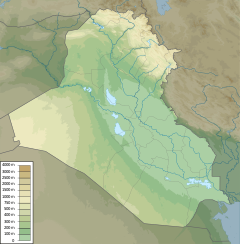| 17th of Ramadan Mosque | |
|---|---|
Arabic: جامع ١٧ من رمضان | |
 | |
| Religion | |
| Affiliation | Islam |
| Ecclesiastical or organisational status | Mosque |
| Status | Active |
| Location | |
| Location | Baghdad, Iraq |
Location in Iraq | |
| Geographic coordinates | 33°18′53″N 44°25′19″E / 33.3147°N 44.4220°E |
| Architecture | |
| Style | Islamic |
| Completed | 1959 |
| Specifications | |
| Dome(s) | 1 |
| Minaret(s) | 1 |
| Site area | 5,000 square metres (54,000 sq ft) |
The 17th of Ramadan Mosque (Arabic: جامع ١٧ من رمضان, romanized: Jami' Sabata'sh Ramaḍān) is a mosque in al-Rusafa, Baghdad, in the eastern Karrada district, opposite al-Firdos Square, in front of the Ishtar Hotel.[1] The mosque dates back to the royal era of Iraq and is considered an important historical landmark since it's located in a significant square in the city.[2]
YouTube Encyclopedic
-
1/5Views:1 2577 8274 882 73117 396548 079
-
Live Iftaar Transmission | Day 17 | Lozells Central Mosque | 17th Ramadan 2023
-
Haj 2023 update | Mecca Madina 2023 | Masjid Ye Nabvi 2023
-
Old MAKKAH from 1700 to 2030 | mecca (makkah) future plan | Haram shareef expansion history
-
Mah e Ramadan Mein Masjid Mein Sona Kaisa Hai?? #MuftiAkmal #shorts
-
20th Ramadan 1442 | Ustadh Yahya Raaby | 1st Taraweeh Salah
Transcription
History
Background
The foundation stone was laid during the reign of King Ghazi of Iraq but work did not complete until the 14 July Revolution on July 14, 1959, by Abd al-Karim Qasim and originally gave it the name "Mosque of the Martyr" but despite the opening, prayers did not take place in the mosque until December 6, 1963, during the era of Abd al-Salam Arif in which it was renamed to the "14th of Ramadan Mosque" in honor of the 1963 Ramadan Ba'ath Revolution.[3][4]
The mosque also has a history of bearing many names, the mosque was originally going to be named "al-Alawiyyah Mosque" but after the 14 July Revolution, it was called the "Republic Mosque." But Qasim wanted to rename it "Mosque of the Martyr" after its opening. On December 6, 1963, the mosque was renamed "14th of Ramadan Mosque."[2]
Later events

In 1959, Abd al-Karim Qasim inaugurated the first Monument of the Unknown Soldier in front of the mosque in al-Firdos Square, and to be a shrine for senior political figures who would visit Iraq and lay wreaths there, and with the fluctuations that affected the mosque with its various names, the square remained bearing the name of al-Firdos, then the monument was demolished in 1959. 1981 and it was re-erected in another place and a statue of former President Saddam Hussein was placed in its stead. During the US invasion of Iraq the statue was taken down and the mosque was renamed to its current name to commemorate the Battle of Badr. The square, along with the mosque, became a symbol of the end of an era and the beginning of a new Iraq, however, it also symbolized the chaos that would come after the invasion.[3][4] Nowadays, the mosque remains active with Friday prayers being held in it for both Sunni and Shi'a Muslims.[5]
Description

The Mosque is considered important and is distinguished by its beautiful Islamic construction and style, and it is considered one of the ancient urban landmarks of Baghdad. The total area of the mosque is 5,000 square meters, and the mosque contains a large chapel that can accommodate more than 2,500 worshippers. Including a chapel for women, a room for administration and workers, and a garden around the sanctuary. It also contains a house dedicated to the imam and the preacher and a hall for holding religious events and mourning councils. It also holds a center that studies and helps memorize the Quran that goes by the name of "Ahl al-Qur’an Center".[2]
The Mosque also features calligraphy and painting done by the Iraqi master calligrapher Hashem Muhammad al-Baghdadi which is made in the direction of the qibla and overlooks the gardens of the mosque. Al-Baghdadi's contribution to the mosque is frequently considered one of his greatest works.[6]
- General details of the mosque
-
Wall and ceiling decorations in the Mosque's chapel.
-
The inside of the dome.
-
The inside walls of the Mosque.
-
Ornate wooden door in the Mosque.
-
Façade of the 17th of Ramadan Mosque.
See also
- Islam in Iraq
- List of mosques in Iraq
- List of mosques in Baghdad
- Al-Sa'doun Street
- Firdos Square statue destruction
References
- ^ جامع 17 رمضان - محافظة بغداد Archived 2017-12-08 at the Wayback Machine
- ^ a b c 17th of Ramadan Mosque, 2017
- ^ a b ساحة الفردوس أصبحت رمز سقوط نظام صدام وتحولت اليوم إلى أكبر مركز لتبديل العملات في بغداد، أخبــــــار Archived 2018-12-11 at the Wayback Machine
- ^ a b ساحة الفردوس رمز سقوط صدام تسوده الفوضى والاهمال – مجلة الشبكة العراقية، IMN Magazine Archived 2021-01-22 at the Wayback Machine
- ^ صلاة موحدة بين السنة والشيعة في العراق Archived 2019-03-30 at the Wayback Machine
- ^ The genius of Arabic calligraphy, Hashim Muhammad al-Baghdadi, 2014







